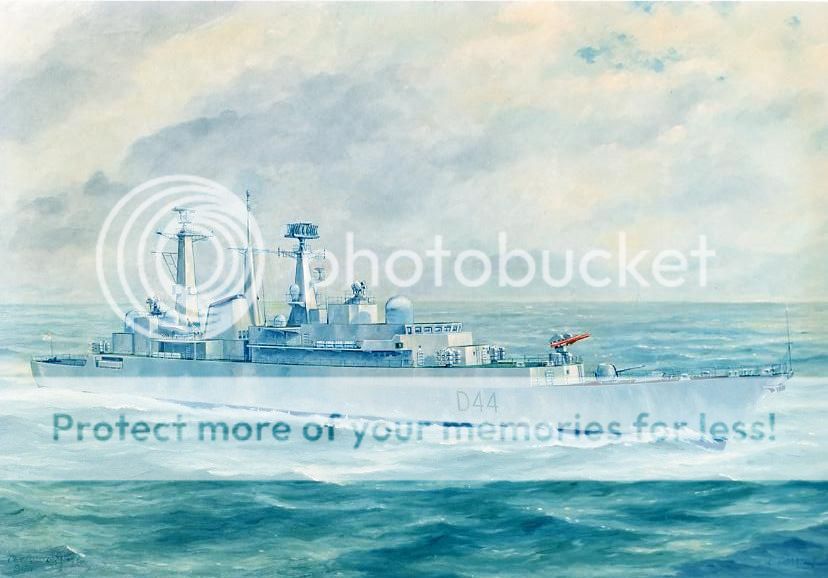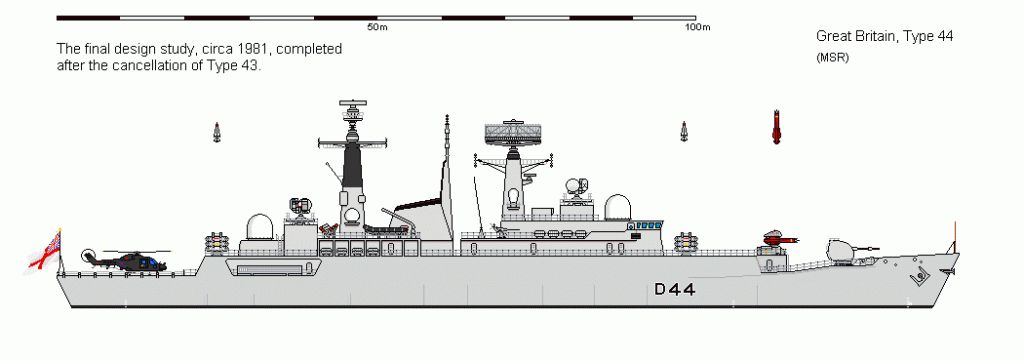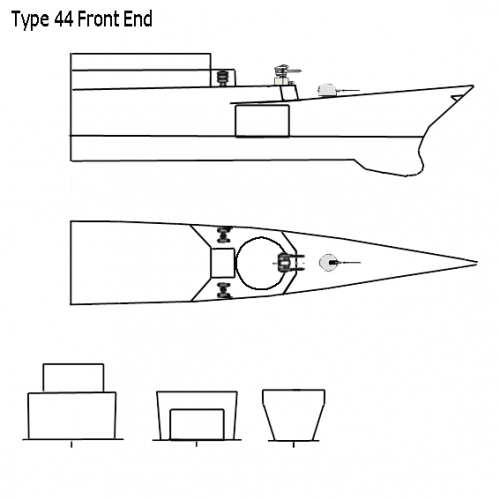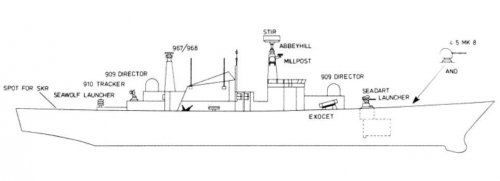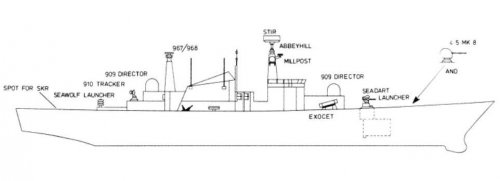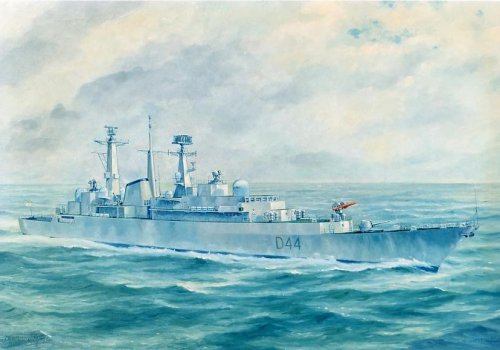Hello, again.
As I said at the end of my last post, any errors are mine and unfortunately, I made some errors in the description of the genesis of the drawing which some of you have already pointed out! I have gone back to my notes and refreshed my memory.
The two questions that need elaboration are the number of GWS25 units, and the depiction of the Mk.8 4.5" main gun in the drawing whereas the painting clearly shows what must be an Oto 76mm.
Regarding Seawolf
I did not reduce the Seawolf launchers to 2 because they wouldn't fit abreast on the hull: I conflated this in my memory with the Seadart ring magazine (which I see RP1 and Abraham Gubler have already mentioned) and its location right up in the fine ends of the bow (which was one of the reasons for lengthening the hull to provide more beam where it was needed, in addition to improving separation between weapon systems).
So, the primary reason for reducing the Seawolf launchers was down to my desire to represent the most likely possible final iteration of the design. (I will expand on this in the next paragraph.) The secondary reason was concerns over exactly how this arrangement would work. I can't remember if it was in conversation with RP1 or with Prof. Gates but the subject of ammo handling for these launchers has come up before and so it contributed to my doubts about their presence in any final design.
Why did I arbitrarily cut the Seawolf launchers? My stated intention throughout this process was to represent what is, on balance and according to available sources (living and dead), the most likely final iteration of the Type 44. This must also include accounting for the budget constraints which led someone to imagine that arbitrarily mandating it be based on the Type 22 would somehow save money.
This was the intellectual climate in which the final design was to be assessed. Add to this Prof. Gates' stories of how some relatively cheap and easy RCS reduction features, such as enclosed boat decks and walkways, received the red pen treatment at an early stage not because they were that expensive, but because they would add pennies to the cost and make it
look more expensive. And this during a time in which several detailed studies had been completed into the efficacy of RCS reduction, Prof. Gates had just authored two papers on the subject, and the Kirov class were receiving a lot of attention from Naval Intelligence because of their apparent RCS features.
P.S. phil, this cost-cutting also answers your question: there is no hangar. Just a flight deck.
Thus, in this climate, and taking into account the technical questions of the efficacy of reloading and operating two GWS25 units in that configuration at that location, I elected to ditch 2 of them to create a far more realistic looking, and better laid out, design. I was pleased to find that Jon didn't find any reason to object to my thinking, and that it tallied with his memories of the goal of the cost reduction measures they were implementing during the design process.
In other words, it was highly likely they would have done it themselves had the project continued.
Regarding the Oto 76mm
I wondered about this fairly early on and have found the email in which I asked Jon. I'll quote part of his reply, directly:
Regarding the Oto76, I am afraid that I can't remember the costs. I would guess that economies of scale would make the Oto cheaper and of course it was smaller so easier to accommodate. Although both Oto and Mk8 put down similar total weights of ordnance per minute, the RN preferred the sporadic big bangs of the Mk 8. In the Falklands they realised a Big Bang every so often was a real 'brown trouser job' for the Argies. The Mk8 was also favoured for all the logistic and maintenance reasons that you mention but we had to explore the advantages and disadvantages of the Oto in the T44 concepts.
With reference to my intention of representing the design that would most likely have been built, we must remember the time lines. This design was cancelled in 1981, at which point it featured a 76mm, no hangar, no RCS reduction, apparently no torpedo tubes and a number of other minor features that one might expect. This was all done to save money.
Now recall that the original iteration of the Type 23 featured a 76mm, no hangar, no 'intentional' RCS reduction (that the superstructure was small and compact was because there wasn't much in it), no torpedo tubes and fairly modest sensors. It was originally just a TAS tug and pit stop for the Sea Kings and Merlins that were envisaged to be operating from a nearby CVS.
After the Falklands more money materialised, and design priorities were reassessed. The Type 23 gained a Mk.8 main gun, a hangar, RCS reduction features built into the superstructure, torpedo tubes, a better sensor fit... you see where I'm going with this?
The Oto was included as a cost reduction feature to test the impact of that change on the bottom line, as Jon clearly states in his final sentence. I think it's reasonable that if the Type 44 had continued, the 76mm would have been replaced post-Falklands with the Mk.8 4.5" and so I drew that, instead.
I hope this wall of text was worth the read and that it answers some questions. I'll make sure to check my notes again before answering anymore!
Cheers



